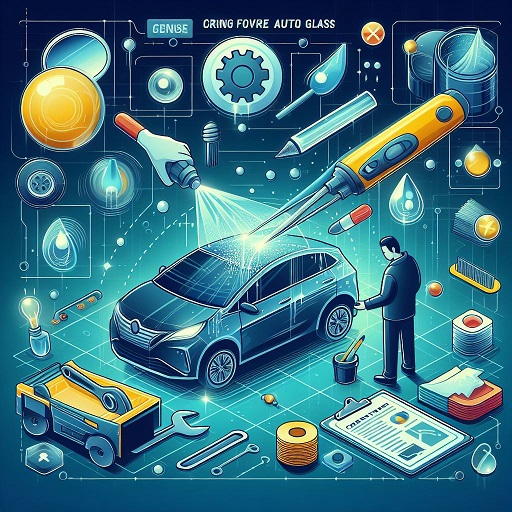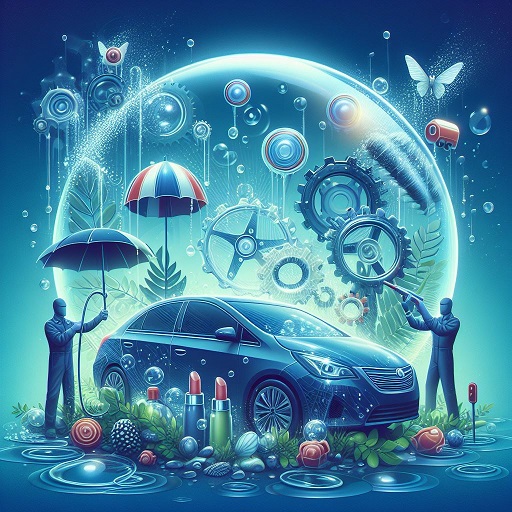Investing in new AutoGlass is a wise decision for any vehicle owner, particularly in Lakewood, CO, where road conditions and varying weather can have a significant impact on your car’s windows. The right care and maintenance can extend the life of your AutoGlass, ensuring it remains clear, intact, and effective in providing safety and comfort during your drives. This comprehensive guide offers an array of tips and tricks, structured into detailed sub-headings, to help you maintain the pristine condition of your AutoGlass.
Understanding AutoGlass Materials
AutoGlass is an essential component of your vehicle, providing structural integrity and safety. In most modern vehicles, the AutoGlass is typically made from laminated safety glass. This type of glass is designed to offer maximum durability and safety. It is composed of two layers of tempered glass with a plastic layer sandwiched in between. This structure is specifically designed to resist impacts and reduce the risk of shattering, which is particularly important in the event of an accident. Understanding this composition is crucial in determining the right care techniques, ensuring your AutoGlass remains effective and durable.
- Composition: Laminated safety glass with two layers of tempered glass and an interlayer of plastic.
- Durability: Designed for impact resistance and to prevent shattering.
- Safety Aspect: Provides structural integrity to the vehicle.
- Care Implication: Understanding material helps in choosing the right maintenance methods.
- Importance: Essential for vehicle safety and comfort.
Regular Cleaning Techniques
Regular cleaning of your AutoGlass is not just about maintaining visibility; it’s also about preserving the glass’s integrity and appearance. Dirt, dust, and other residues can accumulate on your windshield and windows, obstructing your view and potentially damaging the glass over time. To clean your AutoGlass effectively, use a non-abrasive cleaner and a microfiber cloth to avoid scratches. It’s best to perform this cleaning in the shade or during cooler parts of the day, as cleaning in direct sunlight can cause rapid drying, leading to streaks and spots.
- Non-abrasive Cleaner: Ensures the glass is not scratched during cleaning.
- Microfiber Cloth: Ideal for a streak-free finish.
- Avoid Direct Sunlight: Prevents rapid drying and streaks.
- Frequency: Regular cleaning maintains visibility and glass integrity.
- Benefit: Prolongs the life and appearance of AutoGlass.
Dealing with Chips and Cracks
Chips and cracks in your AutoGlass can occur from various sources, such as flying debris or sudden temperature changes. It’s crucial to address these issues promptly. Small chips can often be repaired easily and affordably, preventing them from turning into larger cracks. Larger cracks, however, might necessitate a complete replacement of the glass. Given Lakewood’s temperature fluctuations, these issues can worsen if not dealt with in a timely manner. Regularly inspect your AutoGlass for any damage and consult a professional for repair or replacement as needed.
- Prompt Attention: Address chips and cracks immediately to prevent worsening.
- Repair vs. Replacement: Small chips can often be repaired, while larger cracks may require replacement.
- Professional Consultation: Seek expert advice for the best course of action.
- Regular Inspection: Check for damage regularly, especially after driving in harsh conditions.
- Lakewood’s Climate Consideration: Be mindful of temperature fluctuations that can exacerbate damage.
Protecting Against Extreme Weather

Lakewood’s weather can be particularly challenging for AutoGlass. Extreme temperatures and weather conditions can cause stress and damage to the glass. To protect your AutoGlass, it’s advisable to park your vehicle in shaded areas or use a windshield cover, especially during the summer months. In winter, be cautious not to pour hot water on an icy windshield, as the sudden temperature change can lead to cracking. Gradual defrosting methods, such as using your car’s defrost setting, are safer and more effective.
- Shaded Parking: Protects against extreme heat and UV damage.
- Windshield Cover: Offers protection against elements like snow and ice.
- Avoid Hot Water in Winter: Prevents cracking due to thermal shock.
- Gradual Defrosting: Safely removes ice without damaging the glass.
- Seasonal Considerations: Adapt protection methods to seasonal weather changes.
Safe Driving Practices
Safe driving habits are key to the longevity of your AutoGlass. While on the road, maintain a safe distance from other vehicles, especially on highways and gravel roads, to minimize the risk of flying debris hitting your windshield. High speeds can increase the likelihood and impact of debris, potentially leading to chips or cracks. Additionally, avoiding rough terrain and construction areas when possible can further reduce the risk of AutoGlass damage. These practices not only protect your AutoGlass but also contribute to overall driving safety.
- Maintain Distance: Reduces the risk of debris from other vehicles.
- Avoid High Speeds: Minimizes impact force of any hitting debris.
- Cautious on Rough Roads: Lessens chances of damage on uneven surfaces.
- Bypass Construction Areas: Avoids potential hazards from loose materials.
- Overall Safety: Enhances driving safety while protecting AutoGlass.
Choosing the Right Wipers
Windshield wipers are an often overlooked but crucial component in maintaining your AutoGlass. Worn-out wipers can cause scratches on the glass, which can impair visibility and necessitate costly repairs. Replace your wipers every six to twelve months, or sooner if you notice streaking or ineffective clearing. Using windshield washer fluid instead of water is also important, as it is formulated to clean effectively and prevent freezing in colder temperatures. Regular checks and timely replacements of wipers ensure a clear view and prevent AutoGlass damage.
- Timely Replacement: Change wipers every 6-12 months or when worn.
- Use Washer Fluid: Cleans effectively and prevents freezing.
- Avoid Scratches: Worn wipers can scratch the glass.
- Regular Checks: Monitor wiper condition and effectiveness.
- Visibility and Protection: Ensures clear vision and prevents AutoGlass damage.
Avoiding Chemical Damage
The chemicals that come into contact with your AutoGlass can significantly impact its condition. Avoid using ammonia-based cleaners, as they can damage the tint and weaken the glass over time. Instead, opt for cleaners specifically designed for automotive glass, which are gentle yet effective. These products not only clean your AutoGlass effectively but also contribute to its longevity by avoiding harsh chemical reactions that can degrade the glass quality.
- No Ammonia-Based Cleaners: Prevents damage to tint and glass.
- Automotive-Specific Cleaners: Formulated for gentle and effective cleaning.
- Chemical Reactions: Avoid harsh chemicals that can degrade glass.
- Preserving Tint: Maintains the quality and effectiveness of window tints.
- Long-Term Care: Contributes to the longevity of AutoGlass.
Importance of Professional Installation
When it comes to replacing your AutoGlass, professional installation is key. An expertly installed windshield ensures a secure, leak-proof fit, which is essential for both safety and comfort. In Lakewood, CO, seek out certified technicians with a track record of quality AutoGlass installation. They will have the expertise to handle the installation correctly, ensuring that your new AutoGlass is perfectly aligned and sealed. This not only prevents future issues like leaks or wind noise but also ensures that the safety features of your AutoGlass are fully functional.

- Certified Technicians: Ensure quality and expertise in installation.
- Leak-Proof Fit: Professional installation guarantees a secure fit.
- Alignment and Sealing: Crucial for the effectiveness of AutoGlass.
- Preventing Future Issues: Avoids leaks, wind noise, and other problems.
- Safety Features: Ensures the AutoGlass performs its safety functions properly.
Regular Inspections
Regular inspections of your AutoGlass are a proactive way to identify and address potential issues before they escalate into significant problems. Inspect your AutoGlass for any signs of wear, such as minor cracks, chips, or scratches. Additionally, check the seals and edges of the glass to ensure they are intact and not deteriorating. These inspections, which can be done during routine car maintenance, are crucial in preventing small issues from turning into major repairs or safety hazards, especially considering the varying environmental conditions in Lakewood, CO.
- Inspect for Damage: Look for cracks, chips, and scratches.
- Check Seals and Edges: Ensure they are intact and not deteriorating.
- Routine Maintenance: Incorporate inspections into regular car care.
- Preventative Measure: Identifies issues before they become major problems.
- Environmental Considerations: Adapt to Lakewood, CO’s varying conditions.
Utilizing AutoGlass Coatings
AutoGlass coatings are an additional measure to protect and enhance your windshield and windows. These coatings can provide various benefits, such as repelling water, reducing glare, and offering a degree of protection against minor scratches. They also make cleaning easier and can significantly improve visibility during adverse weather conditions. Consider applying a high-quality coating to extend the life of your AutoGlass and improve your driving experience, especially in the unpredictable weather of Lakewood, CO.
- Water Repellent: Makes driving in rain safer with improved visibility.
- Glare Reduction: Enhances comfort and safety in bright conditions.
- Scratch Protection: Offers a layer of protection against minor abrasions.
- Ease of Cleaning: Coatings can make AutoGlass easier to clean.
- Weather Adaptation: Particularly beneficial in Lakewood’s varied climate.
